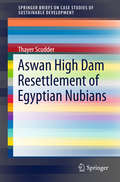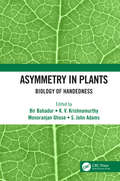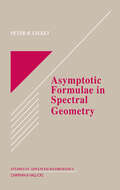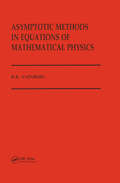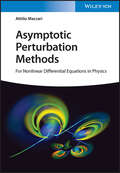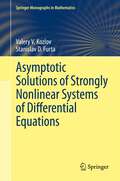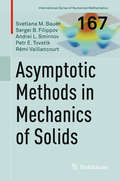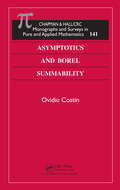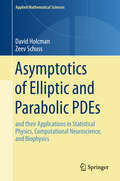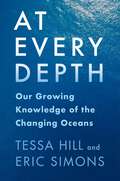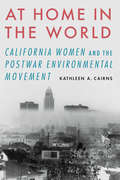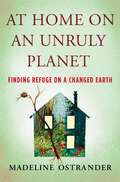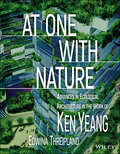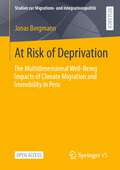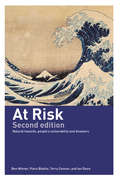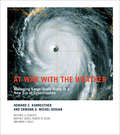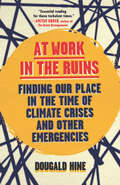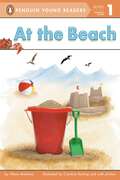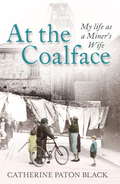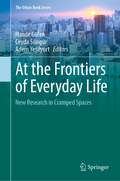- Table View
- List View
Aswan High Dam Resettlement of Egyptian Nubians (SpringerBriefs on Case Studies of Sustainable Development)
by Thayer ScudderThis book highlights the long-term resettlement process of the Egyptian Nubian people along the Aswan High Dam. Assessing the resettlement of 48,000 Egyptian Nubians in connection with the High Dam is especially important for three main reasons: firstly, this resettlement process is one of the rare cases in which research begun before the dam was built has continued for over forty years. Secondly, the resettlement of the Egyptian Nubian people is one of the few cases in which the living standards of the large majority improved because of the initial political will of the government, combined with Nubian initiatives. Thirdly, given the complexity of the resettlement process, weaknesses in government planning, implementation, and in the weakening of government political provide valuable lessons for future dam-induced resettlement efforts.
Asymmetry in Plants: Biology of Handedness
by Bir Bahadur K. V. Krishnamurthy Monoranjan Ghose S. John AdamsPlants exhibit forms of asymmetry analogous to "handedness" in bilaterally symmetrical animals. This book explores the evolutionary significance and development of asymmetry. Examples of genetic control include the direction of tendril or stem coiling of many climbing plants; the so-called spiral phyllotaxy and floral taxy; and contorted petal arrangement is another kind of left- right symmetry in plants; the direction of contortion is fixed in some but not in other plants. The book will underscore tha all phenomena related to handedness start during embryogenesis itself, with the occurrence of embryo rotation. Key selling features: First consolidated book on Plant Handedness Relates handedness, asymmetry and chirality to the evolution of different organizational levels in plant biology Emphasizes handedness as a vital governing force in plant functional evolution Provides a new perspective, hitherto ignored, into plant developemtn and evolution Describes how an age-old phenomenon can give scope for investigation from a very modern interdisciplinary approach
Asymptotic Expansions and Summability: Application to Partial Differential Equations (Lecture Notes in Mathematics #2351)
by Pascal RemyThis book provides a comprehensive exploration of the theory of summability of formal power series with analytic coefficients at the origin of Cn, aiming to apply it to formal solutions of partial differential equations (PDEs). It offers three characterizations of summability and discusses their applications to PDEs, which play a pivotal role in understanding physical, chemical, biological, and ecological phenomena. Determining exact solutions and analyzing properties such as dynamic and asymptotic behavior are major challenges in this field. The book compares various summability approaches and presents simple applications to PDEs, introducing theoretical tools such as Nagumo norms, Newton polygon, and combinatorial methods. Additionally, it presents moment PDEs, offering a broad class of functional equations including classical, fractional, and q-difference equations. With detailed examples and references, the book caters to readers familiar with the topics seeking proofs or deeper understanding, as well as newcomers looking for comprehensive tools to grasp the subject matter. Whether readers are seeking precise references or aiming to deepen their knowledge, this book provides the necessary tools to understand the complexities of summability theory and its applications to PDEs.
Asymptotic Formulae in Spectral Geometry
by Peter B. GilkeyA great deal of progress has been made recently in the field of asymptotic formulas that arise in the theory of Dirac and Laplace type operators. Asymptotic Formulae in Spectral Geometry collects these results and computations into one book. Written by a leading pioneer in the field, it focuses on the functorial and special cases methods of computing asymptotic heat trace and heat content coefficients in the heat equation. It incorporates the work of many authors into the presentation, and includes a complete bibliography that serves as a roadmap to the literature on the subject. Geometers, mathematical physicists, and analysts alike will undoubtedly find this to be the definitive book on the subject.
Asymptotic Methods in Equations of Mathematical Physics
by B VainbergThis book provides a single source for both students and advanced researchers on asymptotic methods employed in the linear problems of mathematical physics. It opens with a section based on material from special courses given by the author, which gives detailed coverage of classical material on the equations of mathematical physics and their applications, and includes a simple explanation of the Maslov Canonical Operator method. The book goes on to present more advanced material from the author's own research. Topics range from radiation conditions and the principle of limiting absorption for general exterior problems, to complete asymptotic expansion of spectral function of equations over all of space. This book serves both as a manual and teaching aid for students of mathematics and physics and, in summarizing for the first time in a monograph problems previously investigated in journal articles, as a comprehensive reference for advanced researchers.
Asymptotic Perturbation Methods: For Nonlinear Differential Equations in Physics
by Attilio MaccariAsymptotic Perturbation Methods Cohesive overview of powerful mathematical methods to solve differential equations in physics Asymptotic Perturbation Methods for Nonlinear Differential Equations in Physics addresses nonlinearity in various fields of physics from the vantage point of its mathematical description in the form of nonlinear partial differential equations and presents a unified view on nonlinear systems in physics by providing a common framework to obtain approximate solutions to the respective nonlinear partial differential equations based on the asymptotic perturbation method. Aside from its complete coverage of a complicated topic, a noteworthy feature of the book is the emphasis on applications. There are several examples included throughout the text, and, crucially, the scientific background is explained at an elementary level and closely integrated with the mathematical theory to enable seamless reader comprehension. To fully understand the concepts within this book, the prerequisites are multivariable calculus and introductory physics. Written by a highly qualified author with significant accomplishments in the field, Asymptotic Perturbation Methods for Nonlinear Differential Equations in Physics covers sample topics such as: Application of the various flavors of the asymptotic perturbation method, such as the Maccari method to the governing equations of nonlinear system Nonlinear oscillators, limit cycles, and their bifurcations, iterated nonlinear maps, continuous systems, and nonlinear partial differential equations (NPDEs) Nonlinear systems, such as the van der Pol oscillator, with advanced coverage of plasma physics, quantum mechanics, elementary particle physics, cosmology, and chaotic systems Infinite-period bifurcation in the nonlinear Schrodinger equation and fractal and chaotic solutions in NPDEs Asymptotic Perturbation Methods for Nonlinear Differential Equations in Physics is ideal for an introductory course at the senior or first year graduate level. It is also a highly valuable reference for any professional scientist who does not possess deep knowledge about nonlinear physics.
Asymptotic Solutions of Strongly Nonlinear Systems of Differential Equations (Springer Monographs in Mathematics)
by Stanislav D. Furta Valery V. Kozlov Lester SenechalThe book is dedicated to the construction of particular solutions of systems of ordinary differential equations in the form of series that are analogous to those used in Lyapunov's first method. A prominent place is given to asymptotic solutions that tend to an equilibrium position, especially in the strongly nonlinear case, where the existence of such solutions can't be inferred on the basis of the first approximation alone. The book is illustrated with a large number of concrete examples of systems in which the presence of a particular solution of a certain class is related to special properties of the system's dynamic behavior. It is a book for students and specialists who work with dynamical systems in the fields of mechanics, mathematics, and theoretical physics.
Asymptotic methods in mechanics of solids (International Series of Numerical Mathematics #167)
by Svetlana M. Bauer Sergei B. Filippov Andrei L. Smirnov Petr E. Tovstik Rémi VaillancourtThe construction of solutions of singularly perturbed systems of equations and boundary value problems that are characteristic for the mechanics of thin-walled structures are the main focus of the book. The theoretical results are supplemented by the analysis of problems and exercises. Some of the topics are rarely discussed in the textbooks, for example, the Newton polyhedron, which is a generalization of the Newton polygon for equations with two or more parameters. After introducing the important concept of the index of variation for functions special attention is devoted to eigenvalue problems containing a small parameter. The main part of the book deals with methods of asymptotic solutions of linear singularly perturbed boundary and boundary value problems without or with turning points, respectively. As examples, one-dimensional equilibrium, dynamics and stability problems for rigid bodies and solids are presented in detail. Numerous exercises and examples as well as vast references to the relevant Russian literature not well known for an English speaking reader makes this a indispensable textbook on the topic.
Asymptotics and Borel Summability (Monographs and Surveys in Pure and Applied Mathematics)
by Ovidiu CostinIncorporating substantial developments from the last thirty years into one resource, Asymptotics and Borel Summability provides a self-contained introduction to asymptotic analysis with special emphasis on topics not covered in traditional asymptotics books. The author explains basic ideas, concepts, and methods of generalized Borel summability, tr
Asymptotics of Elliptic and Parabolic PDEs: And Their Applications In Statistical Physics, Computational Neuroscience, And Biophysics (Applied Mathematical Sciences #199)
by Zeev Schuss David HolcmanThis is a monograph on the emerging branch of mathematical biophysics combining asymptotic analysis with numerical and stochastic methods to analyze partial differential equations arising in biological and physical sciences. In more detail, the book presents the analytic methods and tools for approximating solutions of mixed boundary value problems, with particular emphasis on the narrow escape problem. Informed throughout by real-world applications, the book includes topics such as the Fokker-Planck equation, boundary layer analysis, WKB approximation, applications of spectral theory, as well as recent results in narrow escape theory. Numerical and stochastic aspects, including mean first passage time and extreme statistics, are discussed in detail and relevant applications are presented in parallel with the theory. Including background on the classical asymptotic theory of differential equations, this book is written for scientists of various backgrounds interested in deriving solutions to real-world problems from first principles.
At Every Depth: Our Growing Knowledge of the Changing Oceans
by Tessa Hill Eric SimonsThe world’s oceans are changing at a drastic pace. Beneath the waves and along the coasts, climate change and environmental degradation have spurred the most radical transformations in human history. In response, the people who know the ocean most intimately are taking action for the sake of our shared future. Community scientists track species in California tidepools. Researchers dive into the waters around Sydney to replant kelp forests. Scientists and First Nations communities collaborate to restore clam gardens in the Pacific Northwest.In At Every Depth, the oceanographer Tessa Hill and the science journalist Eric Simons profile these and other efforts to understand and protect marine environments, taking readers to habitats from shallow tidepools to the deep sea. They delve into the many human connections to the ocean—how people live with and make their living from the waters—journeying to places as far-flung as coral reefs, the Great Pacific Garbage Patch, and the Arctic and Antarctic poles. At Every Depth shares the stories of people from all walks of life, including scientists, coastal community members, Indigenous people, shellfish farmers, and fisheries workers. It brings together varied viewpoints, showing how scientists’ research and local and Indigenous knowledge can complement each other to inform a more sustainable future. Poignantly written and grounded in science, this book offers a narrative perspective on the changing oceans, letting us see how our relationships to the oceans are changing too.
At Home in the World: California Women and the Postwar Environmental Movement
by Kathleen A. CairnsFrom the beginning of California&’s statehood, adventurers, scientists, and writers reveled in its majestic landscape. Some were women, though few garnered attention or invitations to join the Sierra Club, the organization created in 1892 to preserve wilderness. Over the next sixty years the Sierra Club and other groups gained prestige and members—including an increasing number of women. But these organizations were not equipped to confront the massive growth of industry that overtook postwar California. This era needed a new approach, and it came from an unlikely source: white, middle-class housewives with no experience in politics. These women successfully battled smog, nuclear power plants, piles of garbage in the San Francisco Bay, and over-building in the Santa Monica Mountains. In At Home in the World Cairns shows how women were at the center of a broader and more inclusive environmental movement that looked beyond wilderness to focus on people&’s daily life. These women challenged the approach long promoted by establishment groups and laid the foundation for the modern environmental movement.
At Home on an Unruly Planet: Finding Refuge on a Changed Earth
by Madeline OstranderFrom rural Alaska to coastal Florida, a vivid account of Americans working to protect the places they call home in an era of climate crisisHow do we find a sense of home and rootedness in a time of unprecedented upheaval? What happens when the seasons and rhythms in which we have built our lives go off-kilter?Once a distant forecast, climate change is now reaching into the familiar, threatening our basic safety and forcing us to reexamine who we are and how we live. In At Home on an Unruly Planet, science journalist Madeline Ostrander reflects on this crisis not as an abstract scientific or political problem but as a palpable force that is now affecting all of us at home. She offers vivid accounts of people fighting to protect places they love from increasingly dangerous circumstances. A firefighter works to rebuild her town after catastrophic western wildfires. A Florida preservationist strives to protect one of North America's most historic cities from rising seas. An urban farmer struggles to transform a California city plagued by fossil fuel disasters. An Alaskan community heads for higher ground as its land erodes.Ostrander pairs deeply reported stories of hard-won optimism with lyrical essays on the strengths we need in an era of crisis. The book is required reading for anyone who wants to make a home in the twenty-first century.
At One with Nature: Advances in Ecological Architecture in the Work of Ken Yeang
by Ken Yeang Edwina Threipland"At One with Nature is an inspiring collection of the latest work of Ken Yeang that further advances sustainable architecture and design. This collection features recent projects as he explores how we can achieve harmony between the natural and our built environments to create a better planet by design. Each project features and highlights not only the systems and devices adopted, but also outlines the intentions and ecological considerations demonstrating best practices for how we can proceed moving forward. The book role models our living Earth and shows how we can behave as stewards of our planet."--Cassia Patel, Oceanic Global Foundation At One with Nature showcases Ken Yeang's latest ideas, built projects designs, research work and advances in the field of designing with nature, a topic that Yeang has pioneered and developed over many decades since receiving his doctorate in ecological design and planning from Cambridge University. His ideas and work are even more pertinent today with the current state of devastation of Earth's natural systems and a biogeochemical cycle that has been extensively and severely impacted by human society. The global environment today is in a state of crisis, but what can society do to address the issues? Yeang's recent projects are presented with instructive diagrams that provide a basis for action for architects, planners, designers, engineers, and anyone whose daily work impinges on the natural environment. Offered in a highly visual, annotated format, with instructive illustrations of Yeang's theoretical books on the topic, At One with Nature is an invaluable resource that students and academics interested in designing with nature will find both informative and relevant.
At Risk of Deprivation: The Multidimensional Well-Being Impacts of Climate Migration and Immobility in Peru (Studien zur Migrations- und Integrationspolitik)
by Jonas BergmannThis open access book examines how and why various forms of climate (im)mobilities can impact people's objective and subjective well-being. Worsening climate impacts are forcing subsistence farmers worldwide to decide between staying or leaving their homes. This mixed methods study analyzes cases of climate-related migration, displacement, relocation, and immobility in Peru's coastal, highland, and rainforest regions. The results reveal that numerous farmers experienced profound and often negative well-being impacts, regardless of whether they stayed or migrated. The higher the structural constraints, such as weak governance, and the more damaging the climate impacts were, the higher the risk of well-being declines. Additionally, the affected individuals often had limited agency and ability to mitigate losses. These findings challenge the notion of "migration as adaptation" and emphasize the importance of safeguarding the human rights and security of those affected while addressing loss and damage. Without significant investments in such efforts, climate impacts could sharply diminish the well-being of numerous subsistence farmers worldwide—irrespective of whether they stay or migrate.
At Risk: Natural Hazards, People's Vulnerability and Disasters
by Ian Davis Ben Wisner Piers Blaikie Terry CannonThe term 'natural disaster' is often used to refer to natural events such as earthquakes, hurricanes or floods. However, the phrase 'natural disaster' suggests an uncritical acceptance of a deeply engrained ideological and cultural myth. At Risk questions this myth and argues that extreme natural events are not disasters until a vulnerable group of people is exposed. The updated new edition confronts a further ten years of ever more expensive and deadly disasters and discusses disaster not as an aberration, but as a signal failure of mainstream 'development'. Two analytical models are provided as tools for understanding vulnerability. One links remote and distant 'root causes' to 'unsafe conditions' in a 'progression of vulnerability'. The other uses the concepts of 'access' and 'livelihood' to understand why some households are more vulnerable than others. Examining key natural events and incorporating strategies to create a safer world, this revised edition is an important resource for those involved in the fields of environment and development studies.
At Risk: Natural Hazards, People's Vulnerability and Disasters
by Ian Davis Ben Wisner Piers Blaikie Terry CannonThe term 'natural disaster' is often used to refer to natural events such as earthquakes, hurricanes or floods. However, the phrase 'natural disaster' suggests an uncritical acceptance of a deeply engrained ideological and cultural myth. At Risk questions this myth and argues that extreme natural events are not disasters until a vulnerable group of people is exposed. The updated new edition confronts a further ten years of ever more expensive and deadly disasters and discusses disaster not as an aberration, but as a signal failure of mainstream 'development'. Two analytical models are provided as tools for understanding vulnerability. One links remote and distant 'root causes' to 'unsafe conditions' in a 'progression of vulnerability'. The other uses the concepts of 'access' and 'livelihood' to understand why some households are more vulnerable than others. Examining key natural events and incorporating strategies to create a safer world, this revised edition is an important resource for those involved in the fields of environment and development studies.
At Road's End: Transportation And Land Use Choices For Communities
by Cy Ulberg Lisa Wormser Dan CarlsonAt Road's End is a timely guide to a new era of holistic transportation. It presents new models for transportation planning, describes effective strategies for resolving community disputes, and offers inspiration by clearly demonstrating that new ways of planning and implementing transportation systems can work.
At War with the Weather: Managing Large-Scale Risks in a New Era of Catastrophes
by Howard C. Kunreuther Erwann O. Michel-KerjanInnovative, long-term strategies for reducing vulnerability to large-scale natural disasters and for providing financial support for disaster victims. The United States and other nations are facing large-scale risks at an accelerating rhythm. In 2005, three major hurricanes—Katrina, Rita, and Wilma—made landfall along the U.S. Gulf Coast within a six-week period. The damage caused by these storms led to insurance reimbursements and federal disaster relief of more than $180 billion—a record sum. Today we are more vulnerable to catastrophic losses because of the increasing concentration of population and activities in high-risk coastal regions of the country. The question is not whether but when, and how frequently, future catastrophes will strike and the extent of damages they will cause. Who should pay the costs associated with catastrophic losses suffered by homeowners in hazard-prone areas?In At War with the Weather, Howard Kunreuther and Erwann Michel-Kerjan with their colleagues deliver a groundbreaking analysis of how we currently mitigate, insure against, and finance recovery from natural disasters in the United States. They offer innovative, long-term solutions for reducing losses and providing financial support for disaster victims that define a coherent strategy to assure sustainable recovery from future large-scale disasters. The amount of data collected and analyzed and innovations proposed make this the most comprehensive book written on these critical issues in the past thirty years.
At Work in the Ruins: Finding Our Place in the Time of Climate Crises and Other Emergencies
by Dougald Hine&‘One of the most perceptive and thought-provoking books …Essential reading for these turbulent times.&’ Amitav Ghosh, author of The Great Derangement&‘Dougald Hine&’s brilliant book demands we stare into that abyss and rethink our securest certainties about what is actually going on in the climate crisis. It&’s lucidly unsettling and yet in the end empowering. There is something we can do, and it starts with where we look, how we see and what we choose to change.&’ Brian Eno, Musician&‘[A] rich book, which like a poetic or religious text deserves multiple readings&’ Richard Smith, British Medical Journal&‘I consider this book a must-read for all those activists feeling lost, desperate and perhaps subject to &‘press-on-itis&’.&’ Gail Bradbrook, cofounder, Extinction RebellionDougald Hine, world-renowned environmental thinker, has spent most of his life talking to people about climate change. And then one afternoon in the second year of the pandemic, he found he had nothing left to say. Why would someone who cares so deeply about ecological destruction want to stop talking about climate change now? At Work in the Ruins explores that question.&‘Climate change asks us questions that climate science cannot answer,&’ Dougald says. Questions like, how did we end up in this mess? Is it just a piece of bad luck with atmospheric chemistry – or is it the result of a way of approaching the world that would always have brought us to such a pass? How we answer such questions also has consequences.Through our over-reliance on the single lens of science, Dougald writes that we are blinded to the nature of the crises around and ahead of us, leading to &‘solutions&’ that can only make things worse. At Work in the Ruins is his reckoning with the strange years we have been living through and our long history of asking too much of science. He offers guidance by standing firmly forward and facing the depth of the trouble we are in, to ultimately, helps us find the work that is worth doing, even in the ruins.
At the Beach (Penguin Young Readers, Level 1)
by Alexa AndrewsHave fun at the beach!In this easy reader, kids will have fun seeing photographs and reading about the fish that live in the ocean, sand castles on the beach, and birds in the sky.
At the Coalface: My life as a miner's wife
by Catherine Paton BlackGrowing up in a mining family, Cath's husband Doug promised his father he wouldn't follow in his dangerous footsteps. But after struggling with terrible poverty in 1970s Scotland, Doug decided a pit job would provide his wife and young family much needed security, despite extraordinary risks to life and limb. Every day, Cath kissed her husband goodbye, not knowing if she'd see him again as he went to work at the coalface. And while her husband toiled deep below, the mother-of-five put her cooking and cleaning skills to use in the colliery canteen. In good times and bad, the miner's wives pulled together as much as their men underground. Then Thatcher swept to power and suddenly loyalties were tested and a fight for survival of a different kind ensued. One for their very existence.
At the Coalface: My life as a miner's wife
by Catherine Paton BlackGrowing up in a mining family, Cath's husband Doug promised his father he wouldn't follow in his dangerous footsteps. But after struggling with terrible poverty in 1970s Scotland, Doug decided a pit job would provide his wife and young family much needed security, despite extraordinary risks to life and limb. Every day, Cath kissed her husband goodbye, not knowing if she'd see him again as he went to work at the coalface. And while her husband toiled deep below, the mother-of-five put her cooking and cleaning skills to use in the colliery canteen. In good times and bad, the miner's wives pulled together as much as their men underground. Then Thatcher swept to power and suddenly loyalties were tested and a fight for survival of a different kind ensued. One for their very existence.
At the Frontiers of Everyday Life: New Research in Cramped Spaces (The Urban Book Series)
by Hande Gülen Ceyda Sungur Adem YeşilyurtThe book provides a critical analysis of the geographies of everyday life, looking at how spatial practices craft w(r)iggle room to cope with the boundaries saturated by normativity, power relations, and inequalities. It explores the possibilities for making do with the everyday practices forming a way of living in cramped spaces. In this respect, early-career researchers and activists share their fieldwork experiences through an intersectional lens based on emerging research methodologies and scholar-activist practices. From their own vantage point, they look at their own contexts, practices, and research subjects at the level of everyday life.Spatial practices and place-based imaginaries from France, Finland, and Spain to Turkey and South Africa present a wide range of non-counter hegemonic yet enabling practices for transformation in everyday life. The contributors, trained in a variety of convergent disciplines concerned with everyday life and space (geography, geopolitics, architecture, urban planning, sociology, political sciences), discuss scholar-activist methodologies during the current crisis in contemporary academia, reflect on their research methodologies and research experiences, and inquire into the ways of embodied negotiations for agency, survival, and care.A group of early-career researchers and activists came together to seek out the possibilities of transformative change in everyday life during the peak periods of COVID-19. When researchers and activists were forced to stay at home in isolation, the authors met up online to discuss their subjectivities self-reflexively to challenge the distance between the researcher and “the field.” The book is the outcome of their collective production based on numerous meetings, writing workshops, and creative debates.
At the Heart of the Coral Triangle: Celebrating Biodiversity
by Alan J Powderham Sancia van der MeijThe Coral Triangle, straddling the confluence of the Indian and Pacific Oceans, harbours the greatest biodiversity of marine life on the planet. It is home to a wondrous variety, including 75% of the world's coral species and around 2500 species of fish. The biological and environmental diversity is driven by the volcanically active and complex geology of the so called 'Ring of Fire'. Habitats range from underwater slopes of volcanic black sand to extensive coral reefs in atolls and vast calderas. While clearly vulnerable to increasing global threats such as climate change, pollution and overfishing, the Coral Triangle currently features some the richest coral reefs in the world. With stunning photography supported by an engaging and accessible text, this book highlights and celebrates this biodiversity along with the underlying message that it needs our care and protection before it is too late.
